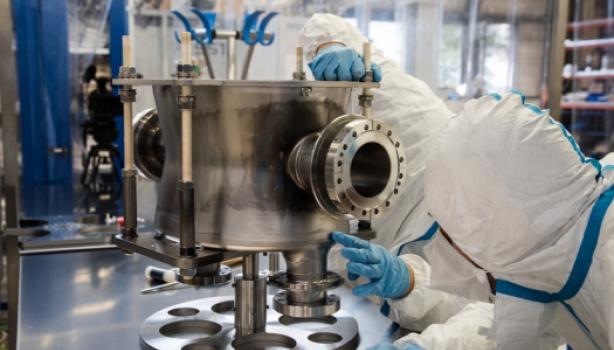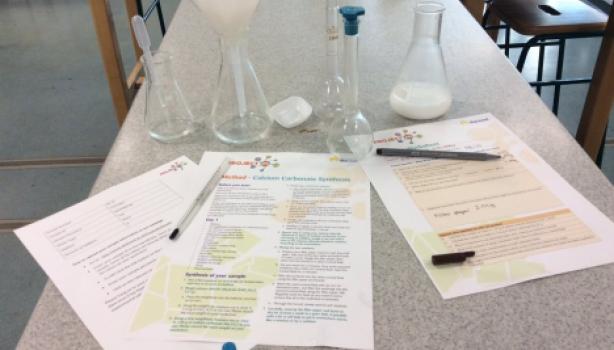Nearly one year after the start of the assembly activities the first 3-module-device Target Dump Injection Segmented (TDIS) unit is ready to be installed. This time span has allowed the project team to troubleshoot and ultimately validate the equipment assembly procedure and its overall design.
One major milestone achieved during this process was the completion of an irradiation experiment at CERN’s HiRadMat facility in 2018. A complete prototype TDIS module was exposed to several high-intensity proton beam pulses, reproducing in its core (two movable assemblies named jaws) the thermomechanical response expected by HL-LHC beam impacts. As anticipated/expected by previous simulations , the jaw assembly, made up mainly of isostatic graphite absorbing blocks supported by an advanced Titanium-Zirconium-Molybdenum (TZM) stiffener, did not show any beam-induced degradation, which was corroborated by online instrumentation and post-irradiation examinations. The outstanding strength at high temperatures along with the remarkable thermal conductivity plus an average specific heat make the TZM the most suitable material to cope with the challenging energy level at the TDIS back-stiffener’s spot. That is why it was chosen over many other candidates such as Glidcop® (used in back-stiffeners of most LHC collimators).
The on-line monitoring of the HiRadMat module also provided an insight into the performance of the built-in cooling system, which was able to cool the jaws down to room temperature within about 10-15 minutes after beam shots (when TZM’s temperature exceeded 200°C). The cooling system was subject of another test aiming at evaluating its capacity to keep the jaw temperature below 50°C while beams are being injected into the HL-LHC. During LHC filling, continuous resistive-wall heating of the TDIS jaws is present, mostly on surfaces directly exposed to particle beams. The testing set-up included four 1000-watt lamps to get the jaws heated up in a manner similar to real-time operation.
Further validation tests were conducted on another essential system of the injection absorber: a complex mechanism containing almost 500 components denominated “mechanical table”, responsible of the 0.01 mm-accurate motion of the jaws inside the vacuum chamber. Two mechanical tables endured, without any hint of fatigue/deteriotation, 15000 full-stroke cycles, pessimistically emulating the expected displacements over the TDIS’s lifetime. Moreover, prior to running the mechanical table cycling test, the lubricated lead screws (by far the most sensitive components of this sub-assembly) were gamma irradiated up to 5 MGy, several factors higher compared to the calculated cumulated dose at the TDIS location in the LHC tunnel. Unlike the other testing activities, the irradiation campaign of the leadscrews took place/was performed at BGS Beta-Gamma-Service GmbH (Wiehl, Germany).
As for the assembly procedure of the injection absorber, specific tools and custom-made benches were developed to ease certain critical operations, namely the mounting of jaws - which requires compressing springs that deliver a total force of 3 tons - and the insertion of the assembled jaws into the chamber. For the latter it is necessary a combination of guided translational and rotational movements of the jaw whilst being significantly close to the delicate surfaces of the jaw and the chamber. Failing to perform it correctly could result in collisions between the two components and hence, for instance, in a leaking vacuum tank or a damaged absorbing surface of the jaw.
Time-lapse of the last activities conducted on the TDIS. (Video: CERN)In terms of the design, the single major modification that the TDIS has undergone in the last year is the reinforcement of the girder that supports the three modules. A truss was added to the structure in order to increase the girder and stiffness and to avoid buckling or torsional deformations that could be produced by axial forces (of approximately 1.5 tons) arising when the device is under vacuum.
Today, the first TDIS unit is going through conditioning to meet ultra-high vacuum specs after successfully passing the rest of the required verifications before installation in point P2 of the LHC. These checks comprise metrological and survey checks and impedance measurements, among others. In parallel, the ongoing assembly of the second unit is planned to finish before the end of August 2020, heading for installation in point P8 by the last quarter of this year. Two additional devices will be constructed and stored as spares, completing the entire TDIS series.





